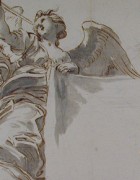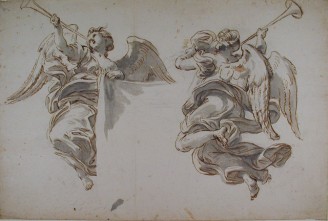Giovanni Battista Gaulli (1639 – 1709)
Two allegorical Figures of Fame
Ashmolean Museum, Oxford (read more)
This post is part of an ongoing online exhibition of images of fame and celebrity held by Oxford University’s Ashmolean Museum. If you’re interested in writing about an exhibit for us, email spotlightoncelebrity@gmail.com with your ideas.
How would you draw fame as a person? Giovanni Battista Gaulli’s pen-and-ink allegorical figures are based on a classical tradition. Virgil had described ‘Fama’ – literally, in English, “what is said” – as a winged woman, who can travel with incredible speed around the world. Virgilian fame is terrifying and unnatural: created by rumour and gossip, it grows from a tiny creature to a giant, and is covered with hundreds of living eyes, mouths, and ears. This is Dryden’s seventeenth-century translation:
Swift is her walk, more swift her winged hast:
A monstrous Fantom, horrible and vast;
As many Plumes as raise her lofty flight,
So many piercing Eyes inlarge her sight:
Millions of opening Mouths to Fame belong;
And ev’ry Mouth is furnish’d with a Tongue:
And round with listning Ears the flying Plague is hung.
She fills the peaceful Universe with Cries;
No Slumbers ever close her wakeful Eyes.
This “flying Plague” remained a familiar symbol through the centuries, with Shakespeare putting it onstage as “Rumour” in Henry IV. Artists like Gaulli, though, needed a less horrible figure for their pictures celebrating the fame of powerful patrons and heroes. A more elegant version of Fama, minus the creepy eyes and extra tongues, holding a courtly herald’s trumpet – to emphasise that fame came from God or Fate, rather than from people talking – became popular. Gaulli’s allegories of Fame are decorative and unthreateningly feminine. They’re almost indistinguishable from Christian angels, and all ready to be attached to the image of any subject he found it profitable to flatter.
Over time, with the creation of mass-media forms like newspapers, fame seemed to become less about “what is said” and more about “what is written.” In a caricature of contemporary artists from the late eighteenth century, James Gillray drew Fame as a covered donkey, covered not with eyes and mouths, but with newspaper headlines and advertising.

